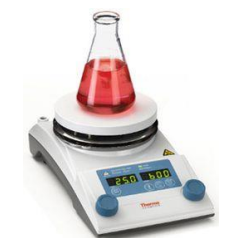Laboratory Hot Plate Safety
Hot plates and other heat producing equipment used in laboratories present many potential dangers to the user. Fires can result when hot devices are located too close to flammable or combustible materials, or because of sparks caused by older or faulty wiring/switches. There is also the risk of burns from accidental contact with a hot surface.
Basic Precautions:
- Periodically test the function of the "off" switch on each hot plate, heating mantle, and water bath to verify that it works and the device cools off quickly when the switch is in the "off" position.
- Always check equipment prior to use. Do not use if the plug or cord are worn, frayed, or damaged, if the grounding pin has been removed, or if a spark is observed. Check for corrosion of the thermostat, which can also cause a spark.
- Never store flammable chemicals or combustible materials near the hot plate, and limit the use of older hot plates for flammable materials.
- Read manufacturer's instructions before using heating devices, and register the device with the manufacturer so you will be notified of any warnings or recalls.
- Keep equipment unplugged when not in use.
Tips for Working Safely with Hot Plates:
- Use only heat-resistant, borosilicate glassware, and check for cracks before heating. Only place borosilicate glassware directly on the hotplate. All other glassware materials may crack and break if placed directly on the hotplate. Make sure that the surface of the plate is larger than the object being heated.
- Use boiling stones or boiling sticks in liquids to facilitate even heating and boiling. Do not evaporate all the solvent or otherwise heat a mixture to dryness this may result in the glass cracking.

- Use medium to medium-high setting to heat liquids, including water. Do not use high setting to heat low-boiling liquids as this can produce surface temperatures as high as 540 °C (1004 °F).
- Do not heat metal pans or foil on a hot plate. It can cause damage to the surface and create sparks.
- Use care when removing hot glassware or when pouring hot liquids. Use tongs or heat-resistant gripping devices/gloves, and remember that glassware may stay hot for some time.
- Turn off hot plates and all other heating devices after use!
Additional safety information on heat producing appliances can be found on pages 18-19 in the WSU Fire Safety Manual.
WSU Office of Environmental Health & Safety
313-577-1200
www.oehs.wayne.edu